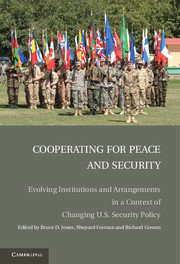 Cooperating for Peace and Security
Cooperating for Peace and Security Book contents
- Frontmatter
- Contents
- Contributors
- Foreword
- Acknowledgments
- I FRAMEWORK
- II ADAPTING COLD WAR INSTITUTIONS
- 4 An Evolving UN Security Council
- 5 Too Many Institutions? European Security Cooperation after the Cold War
- 6 Whither NATO
- 7 The Evolution of Nuclear Nonproliferation Institutions
- 8 9/11, the War on Terror, and the Evolution of Multilateral Institutions
- 9 Evolution and Innovation: Biological and Chemical Weapons
- III NEW TOOLS, NEW MECHANISMS
- IV CONCLUSIONS
- Index
- References
5 - Too Many Institutions? European Security Cooperation after the Cold War
Published online by Cambridge University Press: 22 January 2010
- Frontmatter
- Contents
- Contributors
- Foreword
- Acknowledgments
- I FRAMEWORK
- II ADAPTING COLD WAR INSTITUTIONS
- 4 An Evolving UN Security Council
- 5 Too Many Institutions? European Security Cooperation after the Cold War
- 6 Whither NATO
- 7 The Evolution of Nuclear Nonproliferation Institutions
- 8 9/11, the War on Terror, and the Evolution of Multilateral Institutions
- 9 Evolution and Innovation: Biological and Chemical Weapons
- III NEW TOOLS, NEW MECHANISMS
- IV CONCLUSIONS
- Index
- References
Summary
INTRODUCTION: A WAR OF INSTITUTIONS
In July 2008, the Russian ambassador to the North Atlantic Treaty Organization (NATO) set out proposals to consolidate – or supplant – Europe's patchwork of post–Cold War security institutions. These included a new forum to bring together NATO, the European Union (EU), and the Organization for Security and Cooperation in Europe (OSCE) with Russia's own institutional networks in the former Soviet Union. Although NATO's initial reaction was noncommittal, the initiative played on Western concerns about the incoherence of Europe's security architecture. Russia found a starker way to show the strains affecting that architecture less than a fortnight after its approach to NATO: going to war with Georgia.
Moscow claimed a rapid victory. But this was also a war of institutions. The fighting was the culmination of the erosion of the security framework put in place in Georgia in the early 1990s to freeze its post-Soviet civil wars. This framework included not only Russian and Georgian peacekeepers, co-deployed under the aegis of the Commonwealth of Independent States (CIS) in the separatist enclaves of South Ossetia and Abkhazia, but also monitors from the OSCE in the former and the United Nations (UN) in the latter. This was one of the most convoluted collective security arrangements outside the former Yugoslavia. Its collapse was stimulated by new institutional dynamics – and in turn stimulated a vast amount of institutional activity.
- Type
- Chapter
- Information
- Cooperating for Peace and SecurityEvolving Institutions and Arrangements in a Context of Changing U.S. Security Policy, pp. 80 - 97Publisher: Cambridge University PressPrint publication year: 2009
References
- 1
- Cited by
